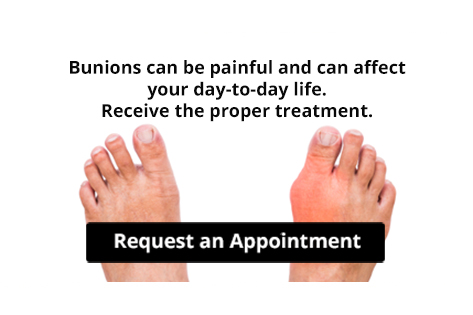Items filtered by date: December 2024
Tibialis Posterior Rupture
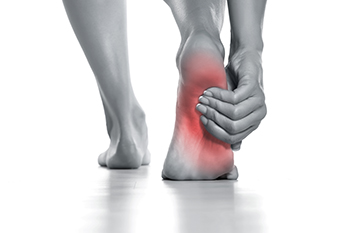
A tibialis posterior rupture is a significant injury involving the tendon that supports the arch of the foot and aids in stability during walking. This tendon is essential for proper foot movement and alignment. Ruptures are often caused by overuse, trauma, or degenerative changes, particularly in individuals with flat feet or those involved in repetitive, high-impact activities. Symptoms include pain along the inner ankle or foot, swelling, difficulty walking, and progressive flattening of the arch. Left untreated, the condition can lead to severe flatfoot deformity and impaired mobility. Diagnosis typically involves a clinical exam, imaging like an MRI scan, and functional assessments. Treatment options range from rest, bracing, and targeted exercises, to surgical repair for severe cases. Early intervention is essential for optimal recovery. If you suspect such a rupture, it is suggested that you consult a podiatrist for evaluation and a tailored treatment plan.
Ankle pain can have many different causes and the pain may potentially be serious. If you have ankle pain, consult with Elliot T. Udell, DPM from New York. Our doctor will assess your condition and provide you with quality foot and ankle treatment.
Ankle pain is any condition that causes pain in the ankle. Due to the fact that the ankle consists of tendons, muscles, bones, and ligaments, ankle pain can come from a number of different conditions.
Causes
The most common causes of ankle pain include:
- Types of arthritis (rheumatoid, osteoarthritis, and gout)
- Ankle sprains
- Broken ankles
- Achilles tendinitis
- Achilles tendon rupture
- Stress fractures
- Tarsal tunnel syndrome
- Plantar fasciitis
Symptoms
Symptoms of ankle injury vary based upon the condition. Pain may include general pain and discomfort, swelling, aching, redness, bruising, burning or stabbing sensations, and/or loss of sensation.
Diagnosis
Due to the wide variety of potential causes of ankle pain, podiatrists will utilize a number of different methods to properly diagnose ankle pain. This can include asking for personal and family medical histories and of any recent injuries. Further diagnosis may include sensation tests, a physical examination, and potentially x-rays or other imaging tests.
Treatment
Just as the range of causes varies widely, so do treatments. Some more common treatments are rest, ice packs, keeping pressure off the foot, orthotics and braces, medication for inflammation and pain, and surgery.
If you have any questions, please feel free to contact our office located in Hicksville, NY . We offer the newest diagnostic and treatment technologies for all your foot care needs.
What Causes Poor Foot Circulation?
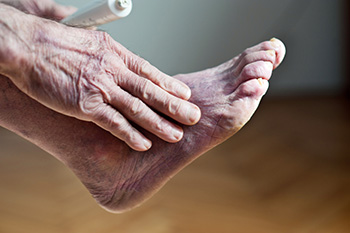
Good blood circulation is essential for overall foot health, as it ensures that the feet receive the necessary nutrients and oxygen to function properly. Poor circulation in the feet can lead to various symptoms, including cold or numb feet, tingling sensations, and swelling. In some cases, the skin may appear pale or have a bluish tint, and wounds may heal more slowly. Causes of poor foot circulation often include conditions such as diabetes, peripheral artery disease, and heart disease. Lifestyle factors such as smoking, sedentary behavior, and excessive alcohol consumption can also contribute. Inadequate blood flow can result in discomfort and more serious complications if left untreated. If you have symptoms of poor foot circulation, it is strongly suggested that you are under the care of a podiatrist who can help you to manage this condition.
Poor circulation is a serious condition and needs immediate medical attention. If you have any concerns with poor circulation in your feet contact Elliot T. Udell, DPM of New York. Our doctor will treat your foot and ankle needs.
Poor Circulation in the Feet
Poor blood circulation in the feet and legs is can be caused by peripheral artery disease (PAD), which is the result of a buildup of plaque in the arteries.
Plaque buildup or atherosclerosis results from excess calcium and cholesterol in the bloodstream. This can restrict the amount of blood which can flow through the arteries. Poor blood circulation in the feet and legs are sometimes caused by inflammation in the blood vessels, known as vasculitis.
Causes
Lack of oxygen and oxygen from poor blood circulation restricts muscle growth and development. It can also cause:
- Muscle pain, stiffness, or weakness
- Numbness or cramping in the legs
- Skin discoloration
- Slower nail & hair growth
- Erectile dysfunction
Those who have diabetes or smoke are at greatest risk for poor circulation, as are those who are over 50. If you have poor circulation in the feet and legs it may be caused by PAD and is important to make changes to your lifestyle in order to reduce risk of getting a heart attack or stroke. Exercise and maintaining a healthy lifestyle will dramatically improve conditions.
As always, see a podiatrist as he or she will assist in finding a regimen that suits you. A podiatrist can also prescribe you any needed medication.
If you have any questions please feel free to contact our office located in Hicksville, NY . We offer the newest diagnostic and treatment technologies for all your foot and ankle needs.
Various Causes of Foot Pain
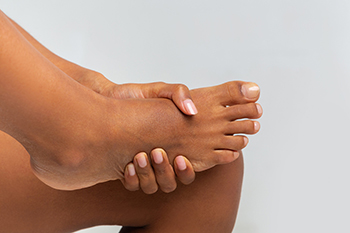
Foot pain can arise from a variety of conditions, including injuries, gout, warts, or bunions. Injuries like sprains, fractures, or strains can cause swelling, bruising, and difficulty walking. Gout, a type of arthritis, causes sudden, intense pain, often in the big toe, accompanied by redness and warmth. Warts, caused by a viral infection, appear as small, rough growths on the skin. Bunions are painful, bony bumps that form at the base of the big toe, often due to tight shoes or genetic factors. The causes of foot pain vary, from trauma and poor footwear to underlying health conditions like arthritis or infections. Treatments range from rest for injuries, medication for gout, to more specialized treatments like padding for warts or surgery for bunions. A podiatrist can provide an accurate diagnosis and effective treatments to relieve pain and prevent future issues. If you are experiencing foot pain, it is suggested that you make an appointment with a podiatrist.
Foot Pain
Foot pain can be extremely painful and debilitating. If you have a foot pain, consult with Elliot T. Udell, DPM from New York. Our doctor will assess your condition and provide you with quality foot and ankle treatment.
Causes
Foot pain is a very broad condition that could be caused by one or more ailments. The most common include:
- Bunions
- Hammertoes
- Plantar Fasciitis
- Bone Spurs
- Corns
- Tarsal Tunnel Syndrome
- Ingrown Toenails
- Arthritis (such as Gout, Rheumatoid, and Osteoarthritis)
- Flat Feet
- Injury (from stress fractures, broken toe, foot, ankle, Achilles tendon ruptures, and sprains)
- And more
Diagnosis
To figure out the cause of foot pain, podiatrists utilize several different methods. This can range from simple visual inspections and sensation tests to X-rays and MRI scans. Prior medical history, family medical history, and any recent physical traumatic events will all be taken into consideration for a proper diagnosis.
Treatment
Treatment depends upon the cause of the foot pain. Whether it is resting, staying off the foot, or having surgery; podiatrists have a number of treatment options available for foot pain.
If you have any questions, please feel free to contact our office located in Hicksville, NY . We offer the newest diagnostic and treatment technologies for all your foot care needs.
Types of Congenital Foot Problems
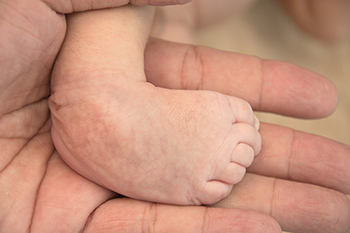
Congenital foot problems can affect a child’s mobility and overall foot function, often requiring medical evaluation and regular care. Clubfoot, also known as talipes equinovarus, is a common condition where the foot and ankle twist inward, often requiring casting or surgery. Metatarsus adductus involves the foot turning inward, sometimes limiting joint flexibility and requiring corrective measures if it does not improve naturally. Another congenital foot condition, metatarsus varus, causes the foot’s arch to rise and the sole to turn inward, frequently needing treatment with a cast to improve alignment. Talipes calcaneovalgus occurs when the foot bends backward with the heel turned outward, and early intervention with braces or a cast is often successful in correcting this. Each of these conditions can affect a child’s ability to walk or develop properly. A podiatrist can assess the severity of the congenital foot condition, recommend appropriate treatments, and provide ongoing care to support healthy foot development. If your child has a congenital foot problem, it is suggested that you schedule an appointment with a podiatrist for treatment.
Congenital foot problems require immediate attention to avoid future complications. If you have any concerns, contact Elliot T. Udell, DPM of New York. Our doctor can provide the care you need to keep you pain-free and on your feet.
Congenital foot problems are deformities affecting the feet, toes, and/or ankles that children are born with. Some of these conditions have a genetic cause while others just happen. Some specific foot ailments that children may be born with include clubfeet, polydactyly/macrodactyly, and cleft foot. There are several other foot anomalies that can occur congenitally. What all of these conditions have in common is that a child may experience difficulty walking or performing everyday activities, as well as trouble finding footwear that fits their foot deformity. Some of these conditions are more serious than others. Consulting with a podiatrist as early as possible will help in properly diagnosing a child’s foot condition while getting the necessary treatment underway.
What are Causes of Congenital Foot Problem?
A congenital foot problem is one that happens to a child at birth. These conditions can be caused by a genetic predisposition, developmental or positional abnormalities during gestation, or with no known cause.
What are Symptoms of Congenital Foot Problems?
Symptoms vary by the congenital condition. Symptoms may consist of the following:
- Clubfoot, where tendons are shortened, bones are shaped differently, and the Achilles tendon is tight, causing the foot to point in and down. It is also possible for the soles of the feet to face each other.
- Polydactyly, which usually consists of a nubbin or small lump of tissue without a bone, a toe that is partially formed but has no joints, or an extra toe.
- Vertical talus, where the talus bone forms in the wrong position causing other bones in the foot to line up improperly, the front of the foot to point up, and the bottom of the foot to stiffen, with no arch, and to curve out.
- Tarsal coalition, when there is an abnormal connection of two or more bones in the foot leading to severe, rigid flatfoot.
- Cleft foot, where there are missing toes, a V-shaped cleft, and other anatomical differences.
- Macrodactyly, when the toes are abnormally large due to overgrowth of the underlying bone or soft tissue.
Treatment and Prevention
While there is nothing one can do to prevent congenital foot problems, raising awareness and receiving neonatal screenings are important. Early detection by taking your child to a podiatrist leads to the best outcome possible.
If you have any questions please feel free to contact our office located in Hicksville, NY . We offer the newest diagnostic tools and technology to treat your foot and ankle needs.
Understanding Common Peroneal Nerve Dysfunction
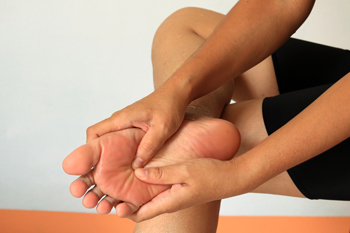
Common peroneal nerve dysfunction is a condition where damage to the peroneal nerve leads to weakness, numbness, or loss of movement in the lower leg and foot. The peroneal nerve branches from the sciatic nerve and controls muscles responsible for lifting the foot and toes. Dysfunction in this nerve can cause foot drop, making it difficult to lift the foot when walking. Causes include direct trauma, prolonged pressure on the nerve, knee injuries, or underlying conditions like diabetes. Diagnosis typically involves a physical exam, nerve conduction studies, and imaging to assess nerve health and identify any underlying issues. Treatment depends on the severity and may involve targeted exercises to strengthen muscles, braces or splints to support the foot, and in some cases, surgery to relieve pressure on the nerve. Early diagnosis and intervention are essential for optimal recovery and preventing long-term complications. If you have symptoms as described, it is strongly suggested that you visit a podiatrist for a proper diagnosis and appropriate treatment.
Some foot conditions may require additional professional care. If you have any concerns, contact Elliot T. Udell, DPM of New York. Our doctor can provide the care you need to keep you pain-free and on your feet.
Rare Foot Conditions
The majority of foot conditions are common and can be treated by a podiatrist. Standard diagnostic procedures are generally used to identify specific conditions and treatment can be rendered. A podiatrist also treats rare foot conditions which can be difficult to diagnose and may need extra attention and care.
There are many rare foot conditions that can affect children. Some of these can include:
- Freiberg’s disease
- Kohler’s disease
- Maffucci syndrome
Freiberg’s disease - This can be seen as a deterioration and flattening of a metatarsal bone that exists in the ball of the foot. It typically affects pre-teen and teenage girls, but can affect anyone at any age. Symptoms that can accompany this can be swelling, stiffness, and the patient may limp.
Kohler’s disease - This often targets the bone in the arch of the foot and affects younger boys. It can lead to an interruption of the blood supply which ultimately can lead to bone deterioration. The patient may limp or experience tenderness, swelling, and redness.
Maffucci syndrome - This affects the long bones in a child’s foot leading to the development of abnormal bone lesions. They are benign growths and typically develop in early childhood and the bones may be susceptible to breaking.
A podiatrist can properly diagnose and treat all types of rare foot conditions. If your child is affected by any of these symptoms or conditions, please don’t hesitate to call our office so the correct treatment method can begin.
If you have any questions please feel free to contact our office located in Hicksville, NY . We offer the newest diagnostic tools and technology to treat your foot and ankle needs.
